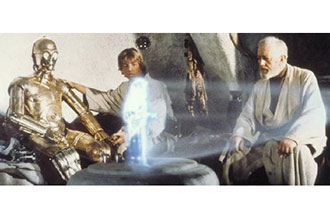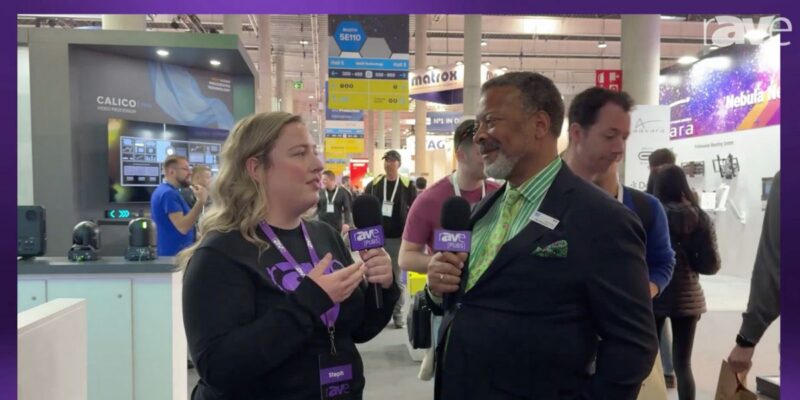Holographic TV in a Galaxy Far, Far Away
By Matt Brennesholtz
DisplayDaily
 The ultimate 3D TV would be a real-time, full color holographic TV system. No glasses would be required, no conflict between accommodation and convergence, no eyestrain. It would, literally, be just like looking through a window.
The ultimate 3D TV would be a real-time, full color holographic TV system. No glasses would be required, no conflict between accommodation and convergence, no eyestrain. It would, literally, be just like looking through a window.
There is a catch, however, besides the public’s ho-hum attitude toward 3D TV. The catch is we can’t do it now and, according to Dr. Michael Bove at the MIT Media Lab, we won’t be doing it anytime soon. Ten years, perhaps, but then again perhaps not.
Dr. Bove is a principal research scientist at Massachusetts Institute of Technology (MIT), as well as Co-Director of the Center for Future Storytelling and Director of the Consumer Electronics Laboratory. He was also co-chair of the 2012 International Symposium on Display Holography (ISDH) at MIT. On October 31, Dr. Bove did a one hour webinar titled “An Introduction to Holographic Television” as part of SMPTE’s Professional Development Academy (PDA).
He started with a discussion of conventional stereoscopic TV. Basic stuff, but you have to understand the problems with current glasses-based stereoscopic TV before you can appreciate the problems that holographic TV would solve.
As part of the basics, he explained what holographic TV was not. Jessica Yellin on TV during the 2008 elections was not a hologram, regardless of what CNN told you. Tupac, Al Gore, Prince Charles, and others not only were not holograms, but as Pepper’s Ghost images generated from 2D displays, they aren’t even 3D. 3D Pepper’s Ghost images can be generated if you use a multiview 3D source, however. Dr. Bove should know because his group has done it. And most of all, Princess Leia in Star Wars wasn’t a hologram, she was a movie special effect. According to physics as we know it, the Princess Leia image was not just not a hologram, but it was impossible. Of course, anyone who has seen Star Wars knows in a galaxy far, far away, physics worked differently.
 A hologram may be like looking through a window, but there has to be a window to look through, as shown in the diagram. (Text in this diagram is my addition, paraphrasing Dr. Bove’s talk.) In the Princess Leia example, there is no window to produce the image. You look straight through the “holographic” image and see not the holographic device producing Princess Leia but Luke Skywalker.
A hologram may be like looking through a window, but there has to be a window to look through, as shown in the diagram. (Text in this diagram is my addition, paraphrasing Dr. Bove’s talk.) In the Princess Leia example, there is no window to produce the image. You look straight through the “holographic” image and see not the holographic device producing Princess Leia but Luke Skywalker.
The problem with holographic TV is a hologram requires a lot of information. The sheer quantity of information required causes problems when:
- You record the image,
- You transmit the image and
- You display the image.
Dr. Bove spent very little time trying to explain how you could capture the holographic image or transmit it. To truly capture a holographic image, you would need a sensor as big as the window. Want a 65” TV? You would need a 65” sensor with a much higher resolution in pixels per inch (PPI) than current sensors. And current sensors aren’t 65”, they are 0.2” – 1.5”, depending on how much you spend on your camera. NASA has bigger sensors, but they also have bigger budgets than most people. And then think about transmitting the data generated by the sensor.
Efforts in holographic TV have focused on using diffraction in microdisplays or other display technologies to generate holographic images. Generally the input data to the display device is not holographic, it is conventional 2D or 3D imaging. A 3D CAD model is just fine, thank you. The digital processor then converts this data into a diffraction pattern that when illuminated with coherent light (e.g., lasers) reproduces the original 3D image. The problem is the display device requires a very large number of pixels that are spaced at roughly the wavelength of light, perhaps 0.5µm. So a 65” 16:9 holographic TV would require a resolution of 2810K. Not 2810 pixels across, but 2,810K pixels. This is roughly 700x the horizontal pixel count of a 4K display, with 493,679x the total pixels. And you thought it was hard to produce a 4K display!
Dr. Bove says there are tricks available to the digital holographer that simplify this problem. Digital holographs can be generated with current technology, if you want a 0.5” image with a 5° field of view. Every technology has to start somewhere, I guess. Dr. Bove estimates it will be about 10 years before holographic TV becomes practical. As an indication of this time span, the ISDH holographic event is held not every year like SID, SMPTE or most other technical conferences, but every three years. The first of these symposia had been held in 1982 and the 2015 conference is already planned.
Personally, I would guess holographic TV will take longer than 10 years. Maybe in 10 years Dr. Bove and his colleagues will have demonstrated technical feasibility of holographic TV. But it’s a long way from technical feasibility to a SMPTE Standard and a holographic TV in every home.




